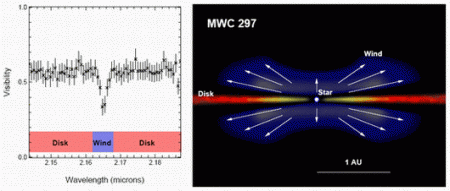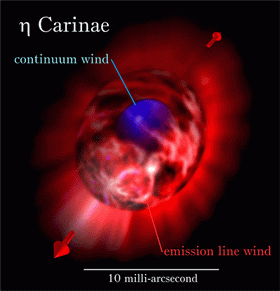First astrophysical results with AMBER/VLTI

The AMBER instrument installed at the Very Large Telescope (VLT) of the European Southern Observatory (ESO) combines the light from three 8.2 meter telescopes, making the VLT the world’s largest optical telescope, with a total mirror surface larger than 150 m2 and a maximum telescope separation greater than 130 m. Two years after installation, the first astrophysical results are blossoming. They are being published this week as a special feature in Astronomy & Astrophysics.
AMBER is one of the two science instruments of the Very Large Telescope Interferometer (VLTI). It is an interferometer beam combiner for the VLT, sensitive in the near-infrared wavelength range (from 1 to 2.5 microns). The consortium team installed AMBER at ESO’s VLT in Chile in March 2004 and, although the instrument is still in the test and commissioning process, a wealth of original results about the close environment of a variety of stars have been obtained.

This week, Astronomy & Astrophysics is publishing 11 articles as a special feature on AMBER/VLTI: three of them describe the instrument; the other 8 papers reveal completely new astrophysical results about the early and late stages of stellar evolution.
The principle of the interferometric technique is to combine the light collected by two or more distant telescopes. The greater the distance between the telescopes, the sharper the observations obtained. For the VLTI, this distance can be up to 130 meters, providing observers with milli-arcsecond spatial resolution. With such high spatial resolution – 16 times higher than the resolution from a single telescope – one should be able to distinguish details on the Moon that are about 2 meters in size. In addition to this high spatial resolution, AMBER also provides astronomers with a spectral resolution up to 10000, corresponding to a velocity of 30 km/s.
The first results presented in this issue cover various fields of stellar and circumstellar physics. Two papers deal with Herbig Ae/Be stars, a class of pre-main sequence stars with masses ranging from 2 to 5 solar masses and with ages younger than 10 Myr. These articles present observations of the stellar system MWC 297 (see Fig. 1) and the lower-mass, less active system HD 104237. They offer new information about the geometry of the surrounding disks and of the associated outflowing winds. These results illustrate that AMBER is a major tool for understanding both the very close environment of young stars and their circumstellar gas and dust disks, where planet formation takes place.
Three articles are devoted to hot, active stars of particular interest: a Arae, which is one of the closest Be stars; k Canis Majoris, one of the brightest ones; and CPD -57°2874, a hot star with a peculiar emission-line spectrum. They provide new, precise information about their rotating gas envelopes.
The AMBER team also studied the very massive and luminous star h Carinae. By zooming into the very heart of this enigmatic object, h Carinae was shown to be surrounded by a fast and dense stellar wind that totally obscures the central star. The mass loss due to this stellar wind is enhanced along the polar axis (see Fig. 2) which is also the main axis of the Homunculus nebulae at larger scale. These new observations show the similarities between the present-day wind and the ancient stellar eruptions that have generated the nebulae.
Several papers from this special feature focus on the later stages in a star’s life. Looking at the binary system g2 Velorum, consisting of a Wolf-Rayet star and an O-type star, the AMBER measurements allowed the spectra of the two stars to be disentangled and might bring new information about their colliding winds. Last but not least, the authors observed the famous recurrent nova RS Ophiuchi after it exploded on Feb. 12th 2006. This event has been expected since its last outburst 21 years ago. AMBER was able to detect the extension of the expanding emission only 5 days after the discovery. These observations show a complex geometry and kinematics, far from the simple interpretation of a spherical fireball in extension.
As illustrated above, AMBER’s capabilities, combined with the current VLTI performance, allow astronomers to obtain a profusion of new results on various hot topics in stellar physics, from the earliest to the latest stages of the stellar evolution. When the VLTI achieves full performance, AMBER should be able to reach its most ambitious objectives: observation of the dust tori in active galactic nuclei and of the hot extrasolar planets close to their parent stars.
Source: Journal Astronomy & Astrophysics





















